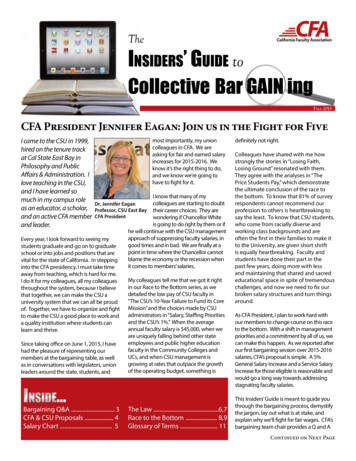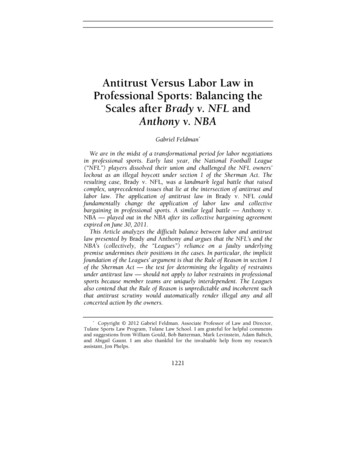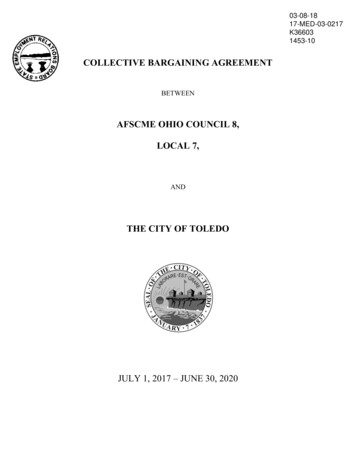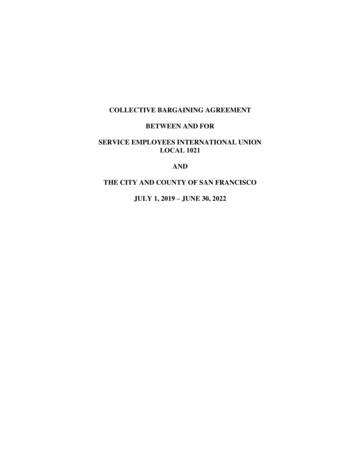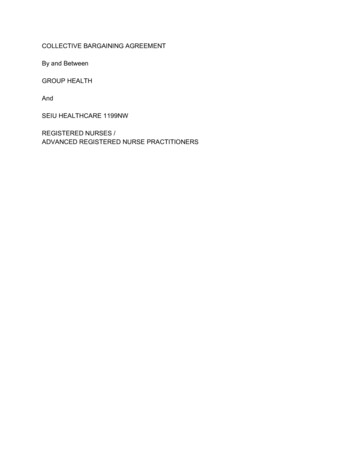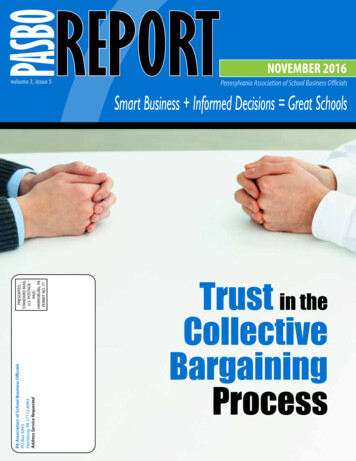
Transcription
PA Association of School Business OfficialsPO Box 6993Harisburg, PA 17112-6993Address Service RequestedPRESORTEDSTANDARD MAILU.S. POSTAGEPAIDHARRISBURG, PAPERMIT NO. 77NOVEMBER 2016volume 3, issue 5Pennsylvennsylvaniaania Association of School Business OfficialsO fficialsTrust in theCollectiveBargainingProcess1November 2016
PASBO BOARD OF DIRECTORSPRESIDENTCurtis O. Richards, PRSBAPRESIDENT-ELECTEdward G. Poprik, PRSBOVICE PRESIDENTRobert E. Saul, PRSBAIMMEDIATE PAST PRESIDENTWanda M. Erb, PRSBADIRECTORSJaclin B. Krumrine, CPAMargaret M. McMinn, PRSBOMatthew Przywara, CPA, PRSBAMark Brooks, PRSBAJohn J. Hurst, CPA, PRSBABrent A. Kessler, PRSBAPatricia T. Bader, PRSBADonna Devlin, PRSBADiane J. Richards, CPA, PRSBAPASBO STAFFPASBOReport Table of ContentsPublished monthly by the Pennsylvania Association of School Business OfficialsFeature ArticleTrust in the Collective Bargaining Process.1Board PerspectiveNovember is the Time to Give Thanks.3Staff InsightsEnergy Management: An Opportunity to Reduce Operating Costs.4Research Articles and TipsA Comment on Device-Agnosticism.6Awards of Achievement - We All Need Your Help!.9Buy Local, Buy Fresh.8Election Rules.3New Hire at PASBO.2Professional Registration Schedule. 13Snow Day Supervision.9Why Apply for the PASBO Award of Excellence in SchoolPurchasing Operations?. 10Why Are School Buses Yellow in Color?.8EXECUTIVE DIRECTORTransitionsJay Himes, CAE, jhimes@pasbo.orgCalendar. 17DIRECTOR OF LEADERSHIP AND DEVELOPMENT Employment. 17Dr. Wayne K. McCullough, PRSBA,Member News. 17wmccullough@pasbo.orgNew Members. 16DIRECTOR OF MEMBER ASSISTANCEIn Each IssueJeffrey S. Ammerman, PRSBA,Colleague to Colleague. 15jammerman@pasbo.orgPASBO Products. 12DIRECTOR OF ADVOCACYRegional Chapter Recap.5Hannah Barrick, hbarrick@pasbo.orgSocial Media Stats. 16INFORMATION SYSTEMS MANAGERStat of the Month. 11Yes, There’s an App for That!. 12Andrew R. Rucker, arucker@pasbo.orgCOMMUNICATIONS MANAGERSuzanne K. Yorty, syorty@pasbo.orgEVENTS AND EXHIBITS MANAGERKaren T. Rogers, CMP, krogers@pasbo.orgFINANCE MANAGERThomas P. Inners, tinners@pasbo.orgPROFESSIONAL DEVELOPMENT MANAGERKimberly A. Pierich, kpierich@pasbo.orgMEMBERSHIP COORDINATORMatthew Q. Wingfield, mwingfield@pasbo.orgPASBO’s mission: Creating great schools by developing outstandingMEMBER ENGAGEMENT COORDINATORschool leaders and providing responsive school business solutionsLynn L. Bubb, lbubb@pasbo.orgMEMBERSHIP ASSOCIATEStephanie E. Stehman, sstehman@pasbo.orgPASBO Report is the official publication of the Pennsylvania Association of SchoolADMINISTRATIVE ASSISTANTBusiness Officials. The publication is intended to inform and educate its readers aboutMichelle Hutchison, mhutchison@pasbo.orgpolicy and technical issues related to school business management. Submit articlesGENERAL COUNSELfor publication to PASBO c/o Communications Manager, (syorty@pasbo.org). ArticlesClarence C. Kegel, Jr., Esq., Attorneywill not be returned and are subject to review, approval and editing prior to publicaNovember 2016tion. Unless otherwise stated in the article, the views and opinions of the authors aretheir own and do not necessarily reflect the positions of PASBO. Articles appearing inPASBO Report may be reprinted with permission of PASBO.2
Feature ArticleTrust in the Collective Bargaining ProcessBY KRISTEN BERGMAIER, FREELANCE WRITERTrust and respect are key aspects whenever two or moreparties enter into a negotiation. When the Association andAdministration come to the table to work out new terms, thisprocess can range anywhere from the good, the bad and the ugly.Each school district develops their own style of negotiation andways to make the process work best for their needs.Three school districts were interviewed on their experiencesduring new contract negotiations, specifically on the process,issues discussed and final outcome of their new contracts. Therewere no major unexpected developments for any of the districtsand all three found ways to compromise for satisfying both sidesof the table. A general consensus was that working together asa team is crucial in finding solutions that benefit the employeesand employers. Remaining respectful, honest and professionalthroughout the process goes a long way in attaining favorableoutcomes.the board did not approve the deal until August, right before theschool year started. According to Richards, “The agreement feltvery fair for both sides and met within the parameters established.”OWEN J. ROBERTS SCHOOL DISTRICTJaclin B. Krumrine, CPA, PRSBAis the Chief Financial Officer andBoard Secretary at Owen J. RobertsSchool District. During negotiations, Krumrine served as ChiefNegotiator under the purview ofthe Board, Superintendent andSolicitor.The new agreement is a twoyear extension off of the existingagreement, which was from July 1,2012 – June 30, 2016. The extension provides for a step incrementand a few additional supplemental units. Language is now included to limit reimbursement of college credit up to nine credits percontract year, when taken through third party vendors affiliatedwith a college or university. Graduate course work beyond a Master’s degree must be part of an approved Master degree programand approved prior to the start of course work.Krumrine explained that negotiations went better than previous years due to the salary, benefit and healthcare structuresremaining consistent from the last round of contract negotiations.“This round of negotiations was cordial,” said Krumrine, andshared that while the Superintendent was at the table, the Solicitor was not and only used as a resource and for approval of finalcontract language.While this extension only took four months to be agreed onand approved, Krumrine expressed her concerns over tough economic times forcing many districts to spend long periods of timebefore coming to a consensus. “In most cases, this will have animpact on the educational process and at the very least a negativeimpact on employee morale and job satisfaction.”LEBANON SCHOOL DISTRICTCurtis O. Richards, PRSBAhas been the Business Managerat Lebanon School District since2006 and has been part of thenegotiation process in the districtfor the past ten years.Negotiations between thedistrict and their professional staff(teachers, counselors and otherswho are certificated) are done inhouse. With no attorney or boardmember present, Richards workswith Chris Danz, Assistant to theSuperintendent for Human Resources. Throughout the process, the board is kept fully informedand legal advice is sought if needed.“It has worked for our district because the board is verytrusting, and they give us parameters and we work within thoseparameters,” said Richards. “Our job is to keep them informedthrough the Superintendent of our progress.”The new agreement is a three-year deal, featuring a true salary increase of a 2.75% average per year for three years. Regardinghealthcare, the base plan moved up to a 500– 1,000 deductible.Also included was a qualified high deductible health plan, whichhas a 2,000– 4,000 deductible. District contributions into ahealth savings account come out to 1,500 for a single personand 3,000 for a family or two-person party.The biggest priority for the administration was the economics, since most of the district’s funding comes from the state andfederal level.“We wanted to be fair with our employees,” shared Richards.“But at the same time, we had to have concessions in healthcare.”Once they had those concessions, they were able to give a reasonable cost of living increase for a three-year contract.Negotiations on the new agreement first started January2016 and finished in June. But with some fine-tuning needed,LANCASTER SCHOOL DISTRICTMatthew Przywara, CPA, PRBAis the Chief Financial & OperationsOfficer at Lancaster School Districtand served as the Chief SchoolAdministrator during negotiationsfor this new contract. He was responsible for the cost analysis ofany change in economic factors.The new agreement was settled about 4.5 months after theprevious contract expired due toa misunderstanding regardinghealthcare noted in the tentativeagreement. Once those were remContinued on next page1November 2016
Feature ArticleCollective Bargainingscale and reaching the top 10% of the regional pay scale by Year3. Affordability for the Districts next three years will have a netcost of 2.9 million and a 1.79% average payroll cost increaseper year, within Act 1 indices.In Przywara’s opinion, the negotiation process works moreeffectively at the local level. “Our relationship is ongoing day-today with the local and the Uniserve Representative adds anotherlayer of bureaucracy that slows the process down.”CONTINUED FROM PAGE 1edied, the agreement was approved. In total, negotiations tookplace over a period of nine months.“The tone always starts out with the Association taking ahard line, normally around specific work rules,” said Przywara. Butthrough an accelerated three full day process, both sides wereable to move quickly through the issues to reach the tentativeagreement. “When we expedited the meetings to three full daysessions, we were able to limit the time and get to the crux of thematters with quick resolution.”The top priority of the Administration was continuing theprofessional development time for all teaching staff. The newagreement has allowed there to be four more hours per monthand flexible scheduling per building to meet particular teacherand student needs.There were also three additional goals met regardinghealthcare, teacher salaries and ensuring District affordability forthree years. Healthcare changes provided employees a range ofaffordable choices, such as high, minimal or no deductible. Salarychanges include starting salaries to mid-range of the regional payNew Hire at PASBOPlease welcome MichelleHutchison to thePASBO team asour Administrative Assistant.In her rolea t PA S B O, M i chelle will answerphone inquiriesfrom members,provide meetingassistance as wellas clerical dutiesin the office andwill also supportthe professional development program.Along with her PASBO role, Michelle will assistthe PA Associaton of School Administrators (PASA)with clerical duties, such as answering the phone,opening mail and meeting assistance.Michelle has association experience, mostrecently working as a secretary/receptionist at thePennsylvania Chiropractic Association.Michelle can be reached at (717) 540-9551 ormhutchison@pasbo.org.All three districts found ways to reach a successful negotiation, either by first-time tactics or methods previously shownto be effective. Over the years, economic hardships have forcedboth districts and their employees to find compromises regardinghealthcare, salaries and more. But the process is never a lost causeas long as both sides maintain a professional approach, developtrust and focus on the education of the children, according toRichards. “When the above relationships are not possible, if youdon’t have trust, if you’re not open and honest and you’re notrespectful, then that process is very time-consuming and veryunproductive.”DATA WITH A FUTURE5Cast is a quantitative analysis and financial projection engine used to assistschool districts in developing annual budgets and multi-year financial plans.5Cast allows you to spendless time doing calculationsand more time analyzingresults. With 5Cast, localgovernment leaders can bein the proactive position ofasking “What if?” rather thanof asking “What now?”Utilize the 5Cast model for collectivecash flow and multi-year forecastsCreate multi-dimensional reports anddata views to support communicationwith various stakeholders groupsInstantly compare and managescenarios to generate unique insightand add depth to your analysisLeverage historical data and builtin analytic tools to accelerate yourplanningAllows for data uploads fromany accounting systemMaintains your user-defined accountcode framework and dimensionsCONTACT:Scott SmithSenior Vice PresidentSales and EngagementNovember 20162P 630.955.7601E ssmith@forecast5analytics.comW forecast5analytics.com
Board PerspectiveNovember is the Time to Give ThanksBY MATTHEW PRZYWARA, CPA, PRSBApeople feel like they matterwhich affects performanceand motivation in simplebut effective ways. An easyplace to start is on Mondaymorning with, “How wasyour weekend?” It’s anunobtrusive question thatshows interest and letsthe receiver decide on thecontent they share.As we round up the election season and move toward themajor holiday season, it is time to reach out to those who arethe backbone of what we do each and every day. To be a greatleader or a great teammate, showing value and acknowledgingcolleagues are integral skills to have in your tool bag and it doesnot have to be a major line item in your district’s budget to makeit happen!You may read that this is what the millennials need in theirwork lives, but the fact is, many people want more acknowledgement in their jobs. It’s part of human nature to need to feel like wematter and make a difference. How does it make you feel whensomeone gives you a “nice job!” Does that make you want to goto your office or cubicle and check your personal email, or hit theground running and do even greater work?Showing appreciation, whether you’re a leader or part of ateam, gives team members the boost they need to stay engagedand productive over time. If you are one that tends to hang outwith the under-acknowledged, try this: Take ownership of yoursituation and be the KUDOS King or Queen. You never know, youcould motivate others to follow the lead. But in the end, makingpeople feel good about the work they’re doing has a reciprocaleffect—it feels good to the giver, too.Here are easy six ideas on how to acknowledge the team.[Tatyana Sussex “5 Ways to Appreciate Your Team Members – andWhy Acknowledgment Matters” Liquid Planner, 5 February 2014.]Provide opportunityIf you’re leading a team, offer training, education or workchallenges that stretch team members to learn and grow. Ifyou’re not the mentor type, make sure everyone has access tothe resources or people they need to keep developing skills andnurture a career trajectory they’re excited about. Be an advocatefor everyone doing their best work in a job they love.Say “thank you.It’s a little phrase that goes a long way and it needs no furtherexplanation.ELECTION RULESVoice your appreciationAcknowledge work well done on a regular basis. Commentscan range from the specific like, “The way you handled that teammeeting was so smart,” to the general, “I appreciate the great workyou do.” If you’re not used to giving kudos, start small (“nice job!”)and then build up. It’s the kind of practice that makes everyonefeel better.The following rules have been adopted by the PASBO Board ofDirectors and shall govern the 2017 election:1. Information regarding a candidate will be published inPASBO Report prior to the election. No other informationshall be published or distributed by the candidate.Send a CardThe art of writing in today’s computer age is on the decline.Take the time to put your thoughts on card stock to show that teammember how much they contribute to the team. Folks will feelvalued that you took the time away from the hustle and bustle touse a pen and express your sincere thoughts in writing. It doesn’thave to be lengthy; a sentence or two will lighten their day.2. Advanced mailings supporting candidates are prohibited.3. Distribution of information about a candidate is restricted towhat is prepared and circulated by the PASBO Nominationsand Elections Committee.4. Badges and stickers promoting a candidate are notpermitted.ListenWhen someone listens to you – whether it’s an idea you’resharing or a project challenge you’re working through, it feelssupportive to have someone all in, witnessing what you’re goingthrough. So put away your cell phone, don’t check your computerscreen for emails and just be there for your co-worker or team.Without the distractions, you might make some breakthroughstogether, who knows!5. Hospitality rooms may not be used to support a candidate.6. Exhibitors may not display or distribute information oncandidates in exhibit booths, hospitality rooms or any otherlocation during or prior to the conference.7. Two copies of these rules will be mailed to each candidateto be signed. One copy shall be returned to the Chairpersonof the Nominations and Elections Committee on or beforeMarch 1, 2017.Ask your team members about their livesWhen you ask team members basic questions about their family and hobbies outside of work, this shows interest in the wholeperson. And like listening, it’s a language of caring, which makes3November 2016
Staff InsightsEnergy Management: An Opportunityto Reduce Operating CostsBY DR. WAYNE K. MCCULLOUGH, PRSBARETROFIT OPPORTUNITIESTake advantage of any opportunity to retrofit equipmentwith updated energy efficient equipment. Lighting technologycontinues to advance rapidly and typically represents the bestpayback retrofit opportunity. If initial funding is problematic,districts might explore “Performance Contracting” as an alternateto self-funding. The latest rendition of this option is HB 39 of 2010,Guaranteed Energy Savings Act.Utilities represent alarge expense for Pennsylvania school districtsand energy managementmay be greatest opportunity for reducing operating costs in your schools.The most recent PASBO Facilities Benchmarking survey, which included data from 2013-2014,indicated the mediancost for utilities for Pennsylvania schools is a median cost of 1.21 per square foot of building space. This data representsFund 10, Function 2600, Object Code 420, Utility Services, and inObject Code 620, Energy. This combination represents the totalfor all natural gas, electricity, bottled gas, water and sewage, plusany other fuel sources and does not include Object Code 530,Communication Utility Costs, or Object Code 411 (410), DisposalServices.Best practices in energy management is schools include thefollowing:PREVENTIVE MAINTENANCEPreventive maintenance saves money because utility usageis reduced and equipment repairs and replacement are limited.Operational changes are often significant opportunities for savings. Are lights left on after hours? Are building controls calibratedon a regular basis? Are filters replaced on a regular basis? Thispractice results in significant unnecessary energy usage and cost.Perform an Energy AuditThe first step in reducing energy is to understand everythingthat consumes energy in your facilities. An energy audit listingeach piece of equipment that uses energy is an important firststep. This important step can also be the foundation of a comprehensive preventive maintenance program.Understand your Utility InvoicesTake time to collect and understand all of the utility invoices.Electric invoices are often very complicated because of demandcharges and transportation charges. It is a best practice to meetwith your electric supplier to make certain you understand theinvoices and all schools are on the best rate schedule.DEVELOPING AN ENERGY POLICYIt is recommended that all school districts create and implement an energy policy. The goal of an energy policy is to conserveenergy so that the instructional program and support services canbe effectively delivered while conserving energy dollars.Benefits of a comprehensive energy policy include:w Saves money because energy is a major source of avoidablespending in schoolsw Shows responsibility to tax payers and redirects money towardseducational needsw Supports the operations & maintenance staff in daily operational decisions and preventive maintenancew Preserves the environmentw Educates students and staff in wise energy habitsThe foundation of the comprehensive energy policy is temperature set points as recommended by the American Society ofHeating, Refrigerating and Air-Conditioning Engineers (ASHRAE).PASBO Consulting ServicesPASBO offers a wide variety of peer consulting services,including energy audits and assistance in energy management.Please contract Dr. Wayne K. McCullough, PRSBA at wmccullough@pasbo.org, if interested.Stay up to date with the latestlegislative news by followingus on Twitter:@TRACK ENERGY USAGEEvery school district should develop a system to track energyusage for their facilities. This process should be done monthly inorder to avoid a rude awakening at the end of the budget year.The PASBO benchmarking study indicated approximately 30%of all school districts in Pennsylvania use Energy Star, (www.Energystar.gov), as a free energy tracking tool.November 2016pasbo orgConference updates andannouncements will be onFacebook and Twitter as well.4
Regional Chapter RecapThe South Central Human Resources Directorsheld its first meeting on Tuesday, October 25, at Central York SD. Themeeting was a great success with 22 human resources professionals fromaround the area in attendance. The South Central HR Directors RegionalChapter includes HR professionals from the following counties: Adams,Cumberland, Dauphin, Franklin, Lancaster, Lebanon, Perry and York.Along with the business meeting that included nominating andelecting officers, discussion on future meeting dates and which schoolsmight be willing to host the meetings, the attendees were treated to aspeaker. Mr. Jeffrey D. Litts, a partner with Kegel, Kelin, Almy & Lord spoketo group about the new FLSA Overtime Rules.The next meeting will take place on December 13, 2016 with thelocation to be determined.Students in the Regional and International Foods class of Central YorkSchool District had a phenomenal learning experience when theyagreed to prepare and serve the luncheon for the inaugural meeting ofPASBO’s South Central Human Resources Regional Chapter. Studentshad to identify the needs of the group, space limitations, a suitablemenu, adjustments to recipes for large groups and other details ofcatering. The students arrived to school early in the morning, dressedin traditional chef coats and hats, and delivered a fabulous Asian mealto the HR officials.Pictured ABOVE (L-R) are President Troy Fisher, Dallastown SD; Vice President Bobbi A. Billman, SPHR, Central York SD; Secretary/Treasurer Lisa M. Greth, LincolnIU# 12; and Board Liaison Brent A. Kessler, PRSBA.BELOW: The October meeting of the Northeast School Business Officials featured guest speaker Jay Himes who presentedan overview of current critical topics.ABOVE: The Northeast School Business Officialsalso welcomed Sandra Miller of the Circuit RiderCampaign for Education Funding. Sandra providedinformation concerning planned future efforts bythe group.5November 2016
TECHNOLOGYA Comment onDevice-AgnosticismBY JEFFREY BUETTLERWhile working in educational technology I am oftenasked, “What is next?” - meaning, can I predict what the nexttech trend will be in order that the academic institution forwhich I work will not feel left behind. For a while I wouldattempt to comb through technology trade rags or sites toprepare for a better answer. I would take that question toheart and try to list devices that I knew were on the marketat the moment or casually mention devices I found outwere in some beta stage of development about to enterthe market. Yet as I continued down this beleagueringpath to answer the “tech-trends” question, I arrived at amore profound answer. Since the development of thedesktop and laptop, not much hastruly changed to the architecture ofcomputers. The obvious exceptionhere is the development of the tablet. The touch-technology is truly thehighlight of the 21st century thusfar. Chances are, touch-devices willcontinue to increase in popularityand worth for many generationsbeyond. Thank you Star Trek!So how do we answer the question, “What’s next?” What pearl ofwisdom can us directors of technology offer? The answer we shouldhave had on the tip of our tonguesall along is, “It doesn’t matter.” Thusends my profound answer and thusthe hint of device agnosticism findsits genesis. As nonchalant as it seems, “It doesn’t matter,”implies a lot. It implies that the curriculum and instructionare sound; the faculty is ready; the culture is secure and thestudents know no different. While this answer (that couldpropel you into a higher standard for using technology)sounds flippant at best - it is not far from where we shouldaspire to be. In short, we should not attempt to answer thequestion of “what is next?” because we never will. Insteadwe, as purveyors of tech tools, should provide the mostflexibility, which, in part answers our dilemma by saying, “Itdoesn’t matter.because your content and information donot require anything specific.” The provision of content thatdoes not rely on the hardware upon which it is presentedmeans that your curriculum and instruction can developat different rates, allowing them to properly breathe andevolve. Teachers can accept digital age learning toolsat different rates (or not at all). Along with instructionalpractices, the culture of the learning institution evolvesand students settle into a learning environment similar tothe era in which they live. An era fraught with variationand micro-cultures defining the platform upon which theywill communicate and share - and all along they are nothindered by the variations in devices, because it doesn’tmatter.So what does this have to do with being device agnostic? To understand what this term means, we must breakNovember 2016it down into its fundamental parts. The ‘device’ in question is thetechnology to which students and teachers have access. Thismight be a tablet, a laptop, a Chromebook, a desktop workstation,etc. Agnosticism is typically a word to define a certain opinionof a higher-power or lack thereof. For our purposes, the worddescribes the notion that no one device or tool is meant to bethe definitive tool; therefore, implying any tool can enhance yourwork. The combining of the two words, device-agnostic, meansour content and information is accessible using any platformthat is not beholden to any one kind of device. The informationis accessible and shareable in a non-proprietary environment. Acommon and well known device-agnostic environment is onewhere BYOD is accepted. BringYour Own Device practices allowstaff and/or students to bringtheir own personal technologyto use in collaboration withothers, because the content isgenerally accessible.When polled (a survey I performed in my own district), mostof the feedback we receivedwas geared towards wantingbetter connectivity; faculty andstudents alike. There was minimal feedback on the kinds ofdevices because the teachers’focus was on getting instructional material in the hands ofthe students using a commonplatform. Seizing upon this opportunity to lay the building blocksof a device-agnostic learning environment, the district “wentGoogle.” Google’s mission is to organize the world’s informationand make it universally accessible and useful. “Why not add thatto our own mission,” we thought. By thinking in this mannerand simply making information useful our tech trend is far lesscomplicated. Professional development is more meaningful andwe are speaking the same language. Some might say - placingyour hopes and dreams in Google has proprietary implicationsand therefore not device-agnostic. Perhaps, yet I can imagineliving in a world where Office 365 and SharePoint are the platform or a Learning Management System the likes of Schoologyor Canvas or Desire2Learn are the platform, and I am still able toaccess my content. At the end of the day the information mustreside somewhere - acceptance of the platform or collection oftools is what will make it most effective. In addition, the learninginstitution must have champions of this learning environment.The practice of making the content
LEBANON SCHOOL DISTRICT Curtis O. Richards, PRSBA has been the Business Manager at Lebanon School District since 2006 and has been part of the negotiation process in the district for the past ten years. Negotiations between the district and their professional staff (teachers, counselors and others who are certificated) are done in-house.



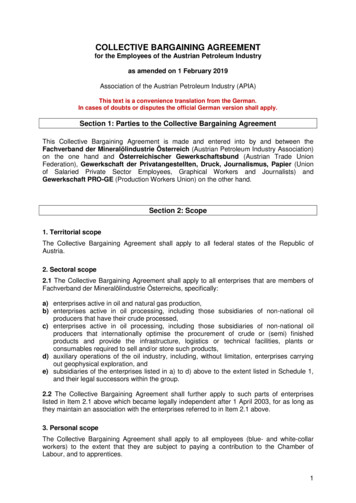
![Labour Act [Chapter 28:01] and Selected Regulations - Zctu](/img/48/labour-20act.jpg)

